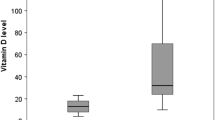Objectives:
This study sought to clarify the relationship between the degree of intracellular magnesium deficiency and the frequency of anginal attacks in women with variant angina.
Patients and Methods:
We evaluated the intracellular and extracellular magnesium status of twelve women with variant angina: group A (≥ 4 attacks/week, n = 5) and group B (< 4 attacks/week, n = 7). Magnesium levels were determined in serum, urine, and erythrocytes, and the 24-h magnesium retention rate was calculated by magnesium loading test.
Results:
Group A showed a higher 24-h magnesium retention rate (58.2 ± 9.1% vs. 31.3 ± 4.4%; p < 0.01) and a lower intracellular concentration of magnesium in erythrocytes than group B (3.1 ± 1.1 vs. 5.0 ± 0.8 fg/cell; p < 0.05), demonstrating the presence of magnesium deficiency in group A. The 24-h magnesium retention rate and intracellular concentrations of magnesium in erythrocytes correlated well with the activity of variant angina (r = 0.61, p < 0.01; and r = –0.74, p < 0.01, respectively) for these patients.
Conclusion:
This study demonstrates that the degree of intracellular magnesium deficiency in women with variant angina is closely related to the frequency of chest pain.
Ziel:
Die Untersuchung sollte die Beziehung zwischen dem Ausmaß des intrazellulären Magnesiumsmangels und der Häufigkeit von pektanginösen Epsioden bei Frauen mit „Variant Angina“ (Prinz-Metal-Angina) untersuchen.
Patienten und Methoden:
Wir untersuchten den intrazellulären und extrazellulären Magnesiumspiegel in zwölf Frauen mit „Variant Angina“: Gruppe A (≥ 4 Episoden/Woche n=5), (Gruppe B < 4 Episoden/Woche n = 7). Die Magnesiumspiegel wurden in Serum, Urin und Erythrozyten bestimmt und die 24-stündige Magnesiumretentionsrate wurde mittels eines Magnesiumbelastungstestes rechnerisch ermittelt.
Ergebnisse:
Gruppe A zeigte eine höhere 24-Stunden-Magnesiumretentionsrate (58,2 ± 9,1 % vs. 31,3 ± 4,4%; p < 0,01) und eine niedrigere intrazelluläre Magnesiumkonzentration in Erythrozyten im Vergleich zur Gruppe B (3,1 ± 1,1 vs. 5,5 ± 0,8 fg/Zelle; p < 0,05). Hieraus ergibt sich zwangsläufig ein Magnesiummangel für die Gruppe A. Die 24-stündige Magnesiumretentionsrate und intrazelluläre Konzentration von Magnesium in den Erythrozyten korrelierten gut mit der Angina-Aktivität (r = 0,61, p < 0,01; r = -0,74, p < 0,01) für diese Patienten. Diese Untersuchung zeigt, dass das Ausmaß des intrazellulären Magnesiummangels in Frauen mit Prinz-Metal-Angina mit der Häufigkeit der pektanginösen Anfälle assoziiert ist.
Similar content being viewed by others
Author information
Authors and Affiliations
Corresponding author
Rights and permissions
About this article
Cite this article
Guo, H., Cheng, J., Lee, JD. et al. Relationship between the Degree of Intracellular Magnesium Deficiency and the Frequency of Chest Pain in Women with Variant Angina. Herz 29, 299–303 (2004). https://doi.org/10.1007/s00059-003-2471-2
Received:
Accepted:
Issue Date:
DOI: https://doi.org/10.1007/s00059-003-2471-2




